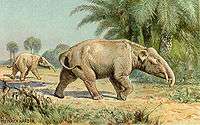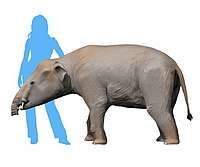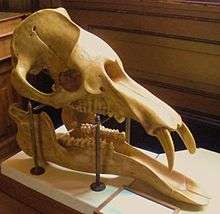Palaeomastodon
Palaeomastodon an extinct genus of Proboscidea. Palaeomastodon fossils have been found in Africa, lived some 36-35 million years ago. They are believed to be the ancestors of elephants or mastodons.[1]

Artistic representation by Heinrich Harder

Life reconstruction of Palaeomastodon beadnelli

Artistic representation
| Palaeomastodon | |
|---|---|
 | |
| P. beadnelli skull | |
| Scientific classification | |
| Kingdom: | |
| Phylum: | |
| Class: | |
| Order: | |
| Family: | †Palaeomastodontidae |
| Genus: | †Palaeomastodon Andrews, 1901 |
| Species | |
| |
Palaeomastodon had tusks, both upper and lower, and it had a trunk. It was about 2.2 metres (7 ft 3 in) tall at the shoulder and weighed about 2.5 tonnes (2.5 long tons; 2.8 short tons).[2] The lower tusks were flat rather than pointed cones, and were probably used to scoop plants from swampy water.
Palaeomastodon was known to have their ears located towards the top of their heads, to make sure their sensory organs remained dry. In addition, their sharp tusks were used as a defense weapon.[3]
References
- The genus Palaeomastodon Archived 2008-10-17 at the Wayback Machine
- Larramendi, A. (2016). "Shoulder height, body mass and shape of proboscideans" (PDF). Acta Palaeontologica Polonica. 61. doi:10.4202/app.00136.2014.
- Osborn, H. F. (1909). "The Feeding Habits of Mœritherium and Palæomastodon". Nature. 81 (2074): 139–140. doi:10.1038/081139a0.
This article is issued from Wikipedia. The text is licensed under Creative Commons - Attribution - Sharealike. Additional terms may apply for the media files.